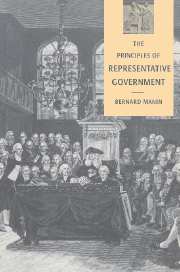Book contents
Conclusion
Published online by Cambridge University Press: 08 March 2010
Summary
Representative government, as we remarked at the beginning of this study, is a perplexing phenomenon, even though its routine presence in our everyday world makes us think we know it well. Conceived in explicit opposition to democracy, today it is seen as one of its forms. The “people” is certainly a much larger entity in our own day than it was in the eighteenth century, the advent of universal suffrage having substantially enlarged the citizen body. But on the other hand, there has been no significant change in the institutions regulating the selection of representatives and the influence of the popular will on their decisions once in office. And it is at least uncertain whether the gap between the governing elites and the ordinary citizens has narrowed or whether the control of voters over their representatives has increased. Nevertheless, we have no hesitation in categorizing today's representative systems as democracies. The founding fathers, by contrast, stressed the “enormous difference” between representative government and rule by what was then the people. We are thus left with the paradox that, without having in any obvious way evolved, the relationship between representatives and those they represent is today perceived as democratic, whereas it was originally seen as undemocratic.
Now, at the end of our journey, it would appear that this difference between the original and modern conceptions is due at least in part to the nature of representative institutions themselves. Representative government includes both democratic and undemocratic features. The duality lies in its very nature, not just in the eye of the beholder.
- Type
- Chapter
- Information
- The Principles of Representative Government , pp. 236 - 238Publisher: Cambridge University PressPrint publication year: 1997
- 1
- Cited by

